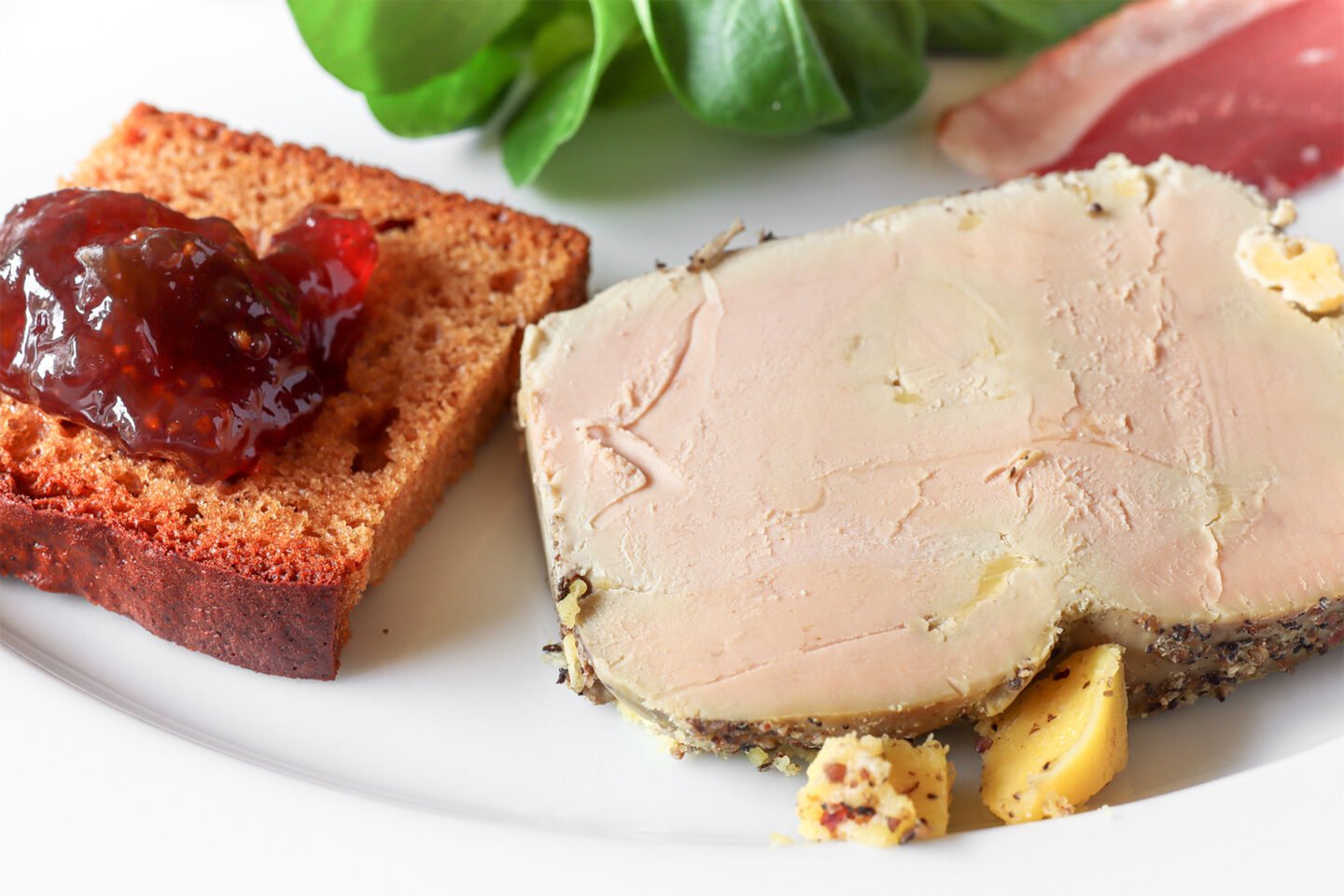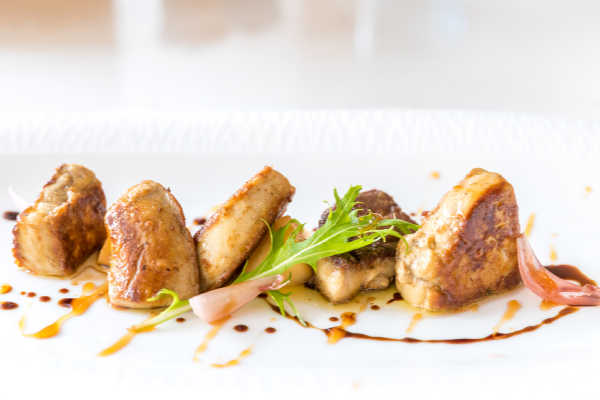So, you've taken a liking to expensive foods? You’ve already ticked off caviar, truffles, and maybe even that nasty-looking geoduck. But what you really want to know is: What does foie gras taste like? In this article, we’ll look at this French delicacy, made from fattened goose or duck livers. We’ll look at the flavor, how to eat it, and lots more.

Table of Contents
Foie Gras Taste: The Quick Answer
Foie gras has a very unique, rich flavor unlike any other food; its taste vaguely compares to liver pate, although its texture is much softer and more delicate. Although you couldn’t compare it to any other type of meat, it does have an intense burst of umami, offering some similarities to a slowly braised beef cheek. The mouthfeel of foie gras is buttery, thanks to its very high fat content.
What affects the flavor of foie gras?
To sum up, how foie gras tastes in one sentence is a challenge as it can vary significantly. There are two major reasons why the version you eat this week is much different from last week’s.
1. Type of poultry
Flavor, texture, fat content, and mouthfeel will change depending on whether duck or goose liver has been used. In general, goose has a milder, less intense taste compared to duck, which has a strong flavor and also less fat content.
2. Preparation method
Bloc de foie gras: this is a block comprising at least 98% foie gras. Very small pieces are tightly compacted into a mold. Additional ingredients can be added, such as wine or truffles. As you can imagine, these extras can drastically change the flavor profile.
Foie gras entier: this is where one or two entire livers are served cooked, semi-cooked, or raw. This option will provide a much better feel for the exact taste that foie gras offers.
3. The final recipe
Although it is perfectly fine to eat this delicacy on its own, there are many recipes that have been developed over the centuries. Pan-frying, sautéing, or searing are all common cooking techniques that add new crispy texture and flavor to the foie gras.
How to Serve Foie Gras
Foie gras is occasionally served as a main course, but it is more commonly used as a starter to put the taste buds into overdrive.
It is important not to overwhelm the foie gras with other pungent flavors or aromas. Instead, look to use subtle ingredients that lift the dish.
Flavors that pair well include:
- garden salad
- oyster mushrooms
- crusty bread
- fig jam
- berry jam or sauce
- sweet white wine
Foie Gras vs Pate
Foie gras is always made from either duck or goose liver and is considered a delicacy. Due to its scarcity, it is an expensive, luxury food item. Alternatively, pate is easily sourced all-year round and can be made from a wide range of ingredients, including lamb, pork, seafood, beef, poultry, or vegetables.
The texture of foie gras can vary from a whole piece of liver to tiny pieces of the liver pressed into a mold. Pate differs in texture as it is always a ground paste.
Interesting reading:
What do brains taste like? Read our ultimate guide to find out.
A recommended recipe for foie gras

Although there are plenty of recipes that call for this elegant ingredient, it is hard to beat the simplicity of foie gras lathered onto fresh crust bread. Don’t use butter because it will be fat overkill. It’s also best to avoid bread that has extras like seeds or olives, as they’ll detract from the hero of the dish.
If you prefer liver that’s cooked, follow this simple recipe for sautéed foie gras.

Sauteed Foie Gras
Ingredients
- 1 lb fresh foie gras rinsed
- 1 Tbsp butter
- 3 Tbsp balsamic vinegar
- 3 Tbsp plum jam
- salt and pepper to taste
Instructions
- Slice foie gras into 1” cubes and season with salt and pepper.
- Heat a large skillet on medium heat and add butter. Allow it to melt, then add half the foie gras. Sauté for 1 minute, or until browned, making sure not to stir regularly as this will break up the liver. 1-2 gentle stirs will be enough.
- Remove from the pan using tongs and place on a paper towel to remove some of the fat.
- Tip out most of the fat that’s in the skillet and cook the remaining foie gras. Once cooked, drain most of the fat out of the pan and add the rest of the foie gras back into the pan.
- Add the balsamic vinegar and jam, and continue cooking until the liquid begins to bubble.
- Remove from heat and serve with a side of crusty bread.
Is eating foie gras ethical?
Our position on this delicacy is that it should only be bought from suppliers that use ethical production methods. In recent years, a spotlight has been placed on the methods used to make foie gras. A technique, known as gavage, involves force-feeding the poultry by stuffing a tube down their throat and pouring in corn that’s been boiled in fat. This is carried out 2-3 times a day while keeping the birds housed in confined quarters. The end result? Large quantities of fat are deposited on their liver, which is what provides that sought-after mouthfeel.
Some countries have stopped the gavage process and have adopted more humane methods. Much of Europe, Australia, India, Argentina, the U.S., and Brazil have banned gavage due to animal welfare concerns.
Conclusion
If you like to savor the finer things in life, then, at some point, you may want to try foie gras. The ethically produced version, of course! Before you try it, though, you may want to know what foie gras tastes like. This is a difficult question, as the flavor is very unique. The first sensation you'll notice, after taking your first bite is the buttery mouthfeel. Being 85% fat, it may be too much for some. The taste has some similarity to liver pate, but it has a more intense umami burst and the texture is more delicate.
Foie gras certainly won't be to everyone's taste. Do you love rich, gamey meat like venison, rabbit, or duck and intensely flavored ingredients like truffles or black trumpet mushrooms? If you answered yes, then there's a good chance you'll enjoy foie gras.
What to eat your foie gras with can make all the difference between a good and bad experience. My advice is to simply eat it with some fresh, crusty white bread. Delicious. You may also want to add a dab of jam or chutney along with an undressed salad. These ingredients aren't overpowering in flavor. The sweetness will help to deal with the extreme umami, and as for the salad, it'll provide some relief from the gamey taste.

Leave a Reply